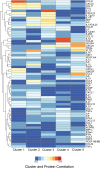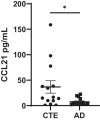Neuroimmune proteins can differentiate between tauopathies
- PMID: 36403052
- PMCID: PMC9675129
- DOI: 10.1186/s12974-022-02640-6
Neuroimmune proteins can differentiate between tauopathies
Abstract
Background: Tauopathies are a group of neurodegenerative diseases where there is pathologic accumulation of hyperphosphorylated tau protein (ptau). The most common tauopathy is Alzheimer's disease (AD), but chronic traumatic encephalopathy (CTE), progressive supranuclear palsy (PSP), corticobasal degeneration (CBD), and argyrophilic grain disease (AGD) are significant health risks as well. Currently, it is unclear what specific molecular factors might drive each distinct disease and represent therapeutic targets. Additionally, there is a lack of biomarkers that can differentiate each disease in life. Recent work has suggested that neuroinflammatory changes might be specific among distinct diseases and offers a novel resource for mechanistic targets and biomarker candidates.
Methods: To better examine each tauopathy, a 71 immune-related protein multiplex ELISA panel was utilized to analyze anterior cingulate grey matter from 127 individuals neuropathologically diagnosed with AD, CTE, PSP, CBD, and AGD. A partial least square regression analysis was carried out to perform unbiased clustering and identify proteins that are distinctly correlated with each tauopathy correcting for age and gender. Receiver operator characteristic and binary logistic regression analyses were then used to examine the ability of each candidate protein to distinguish diseases. Validation in postmortem cerebrospinal fluid (CSF) from 15 AD and 14 CTE cases was performed to determine if candidate proteins could act as possible novel biomarkers.
Results: Five clusters of immune proteins were identified and compared to each tauopathy to determine if clusters were specific to distinct disease. Each cluster was found to correlate with either CTE, AD, PSP, CBD, or AGD. When examining which proteins were the strongest driver of each cluster, it was observed the most distinctive protein for CTE was CCL21, AD was FLT3L, and PSP was IL13. Individual proteins that were specific to CBD and AGD were not observed. CCL21 was observed to be elevated in CTE CSF compared to AD cases (p = 0.02), further validating the use as possible biomarkers. Sub-analyses for male only cases confirmed the results were not skewed by gender differences.
Conclusions: Overall, these results highlight that different neuroinflammatory responses might underlie unique mechanisms in related neurodegenerative pathologies. Additionally, the use of distinct neuroinflammatory signatures could help differentiate between tauopathies and act as novel biomarker candidate to increase specificity for in-life diagnoses.
Keywords: Biomarkers; CSF; Immune; Neurodegeneration; Neuroinflammation; Tau; Tauopathies.
© 2022. This is a U.S. Government work and not under copyright protection in the US; foreign copyright protection may apply.
Conflict of interest statement
The authors declare no competing interests.
Figures




Similar articles
-
Prescription of Controlled Substances: Benefits and Risks.2025 Jul 6. In: StatPearls [Internet]. Treasure Island (FL): StatPearls Publishing; 2025 Jan–. 2025 Jul 6. In: StatPearls [Internet]. Treasure Island (FL): StatPearls Publishing; 2025 Jan–. PMID: 30726003 Free Books & Documents.
-
Distinct involvement of the cranial and spinal nerves in progressive supranuclear palsy.Brain. 2024 Apr 4;147(4):1399-1411. doi: 10.1093/brain/awad381. Brain. 2024. PMID: 37972275 Free PMC article.
-
MarkVCID cerebral small vessel consortium: I. Enrollment, clinical, fluid protocols.Alzheimers Dement. 2021 Apr;17(4):704-715. doi: 10.1002/alz.12215. Epub 2021 Jan 21. Alzheimers Dement. 2021. PMID: 33480172 Free PMC article.
-
CSF tau and the CSF tau/ABeta ratio for the diagnosis of Alzheimer's disease dementia and other dementias in people with mild cognitive impairment (MCI).Cochrane Database Syst Rev. 2017 Mar 22;3(3):CD010803. doi: 10.1002/14651858.CD010803.pub2. Cochrane Database Syst Rev. 2017. PMID: 28328043 Free PMC article.
-
Neuropathology in chronic traumatic encephalopathy: a systematic review of comparative post-mortem histology literature.Acta Neuropathol Commun. 2022 Aug 6;10(1):108. doi: 10.1186/s40478-022-01413-9. Acta Neuropathol Commun. 2022. PMID: 35933388 Free PMC article.
Cited by
-
Perivascular glial reactivity is a feature of phosphorylated tau lesions in chronic traumatic encephalopathy.Acta Neuropathol. 2025 Feb 8;149(1):16. doi: 10.1007/s00401-025-02854-x. Acta Neuropathol. 2025. PMID: 39921702 Free PMC article.
-
Blood inflammation relates to neuroinflammation and survival in frontotemporal lobar degeneration.Brain. 2025 Feb 3;148(2):493-505. doi: 10.1093/brain/awae269. Brain. 2025. PMID: 39155063 Free PMC article.
-
CCL21-CCR7 blockade prevents neuroinflammation and degeneration in Parkinson's disease models.J Neuroinflammation. 2025 Feb 2;22(1):31. doi: 10.1186/s12974-024-03318-x. J Neuroinflammation. 2025. PMID: 39894839 Free PMC article.
-
Chronic Traumatic Encephalopathy as the Course of Alzheimer's Disease.Int J Mol Sci. 2024 Apr 24;25(9):4639. doi: 10.3390/ijms25094639. Int J Mol Sci. 2024. PMID: 38731858 Free PMC article.
-
Neuroinflammatory mechanisms may help identify candidate biomarkers in chronic traumatic encephalopathy (CTE).Free Neuropathol. 2025 Jul 14;6:15. doi: 10.17879/freeneuropathology-2025-6382. eCollection 2025. Free Neuropathol. 2025. PMID: 40666430 Free PMC article. Review.
References
-
- Love S, Louis D, Ellison DW. Greenfield’s neuropathology, 2-volume set. 8. Boca Raton: CRC Press; 2008.
-
- Mackenzie IR, Neumann M, Bigio EH, Cairns NJ, Alafuzoff I, Kril J, Kovacs GG, Ghetti B, Halliday G, Holm IE, et al. Nomenclature and nosology for neuropathologic subtypes of frontotemporal lobar degeneration: an update. Acta Neuropathol. 2010;119:1–4. doi: 10.1007/s00401-009-0612-2. - DOI - PMC - PubMed
-
- Montine TJ, Phelps CH, Beach TG, Bigio EH, Cairns NJ, Dickson DW, Duyckaerts C, Frosch MP, Masliah E, Mirra SS, et al. National Institute on Aging-Alzheimer's Association guidelines for the neuropathologic assessment of Alzheimer's disease: a practical approach. Acta Neuropathol. 2012;123:1–11. doi: 10.1007/s00401-011-0910-3. - DOI - PMC - PubMed
MeSH terms
Substances
Grants and funding
LinkOut - more resources
Full Text Sources
Medical
Miscellaneous

